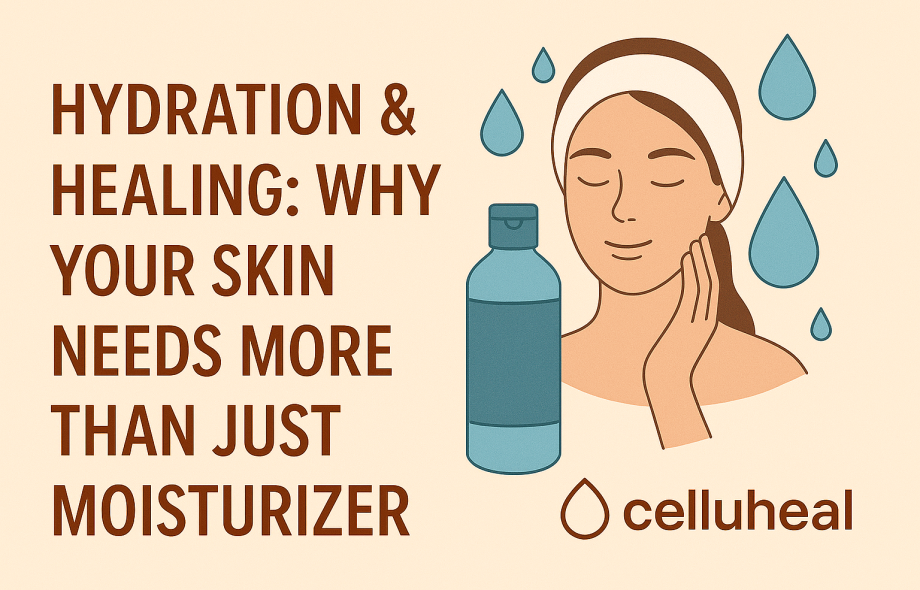Hydration & Healing: Why Your Skin Needs More Than Just Moisturizer
When it comes to skincare, moisturizers often get all the attention. But hydration—the process of maintaining adequate water content within the skin—is about more than simply applying a cream. In fact, for skin to heal effectively from irritation, acne, wounds, or environmental damage, it requires a multi-layered approach to hydration that works from both the inside and out.
Understanding the difference between moisturizing and true hydration can help you build a more effective skincare routine—one that supports not just smooth skin, but skin that recovers and regenerates efficiently.
Hydration vs. Moisturization: What’s the Difference?
Though the terms are often used interchangeably, hydration and moisturization refer to two different (but equally important) functions:
Hydration refers to boosting the skin’s water levels at a cellular level to maintain softness and function.
Moisturizing helps trap existing moisture in the skin and supports the protective barrier that prevents it from drying out.
Think of hydration as quenching your skin’s thirst, while moisturization is about locking that moisture in. Healthy skin needs both. When either is lacking, the skin may appear dry, feel tight, become irritated, or be slower to heal after injury or inflammation.
Why Hydration Matters for Skin Healing
Whether your skin is recovering from acne, a minor wound, or a cosmetic procedure, hydration plays a key role in each phase of the repair process:
Cell Function & Regeneration: Water is essential for cellular activity, including the proliferation and movement of keratinocytes and fibroblasts—cells that rebuild the skin structure.
Barrier Recovery: Proper hydration supports the skin’s outermost layer (the stratum corneum), helping to restore its barrier function after damage.
Reduced Inflammation: Well-hydrated skin is less reactive and better equipped to handle environmental stress, which can contribute to inflammation.
Improved Comfort & Appearance: Dry, tight skin can delay healing and lead to flaking or discomfort. Hydration keeps healing skin soft, flexible, and less prone to cracking.
The Internal Hydration Factor
While skincare products play a role in hydration, what you consume also matters. Your skin draws water from the body, so if you’re dehydrated, your skin may struggle to maintain its balance—even if you apply a moisturizer regularly.
Tips to stay internally hydrated:
Drink water consistently throughout the day.
Eat hydrating foods like cucumbers, oranges, and leafy greens.
Limit excessive caffeine or alcohol, which can dehydrate the body.
Adding sources of omega-3s, such as flaxseeds or fatty fish, can help maintain the integrity of skin cells and support overall skin health.
Hydration from within gives your skin the foundational support it needs to repair, regenerate, and remain resilient.
Ingredients That Help Hydrate the Skin
Hydration-friendly skincare doesn’t stop with a basic lotion. Select skincare products formulated with humectants, as they help draw moisture into the skin and keep it hydrated. Some of the most effective include :Hyaluronic acid, a substance naturally present in the skin, is known for its ability to retain large amounts of moisture, helping to keep the skin plump and hydrated.
Glycerin is an effective humectant that draws moisture from both the air and underlying skin layers to help maintain hydration..
Panthenol (Vitamin B5): Helps soothe and retain moisture, particularly useful in healing skinn.
These ingredients don’t just make the skin feel better—they create an optimal environment for the skin to heal and protect itself.
Moisturizers Still Matter—But They Aren’t Enough Alone
While hydration is critical, moisturizing is what keeps hydration in place. Moisturizers often contain occlusives like petrolatum, dimethicone, or shea butter, which form a barrier on the skin’s surface. This protective layer helps reduce transepidermal water loss (TEWL), which occurs when moisture evaporates from the skin’s inner layers.
For best results, apply moisturizers while your skin is still slightly damp—such as after washing your face or showering. This helps trap existing moisture in the skin before it can evaporate.
Hydration and Wound Recovery
In clinical and home settings, proper hydration can be especially important for wound care. A moist wound environment—not too wet, not too dry—has been shown to promote faster healing, reduce pain, and lower the risk of scarring. Many advanced wound dressings are designed to help manage this balance by keeping the wound adequately hydrated while allowing excess fluid to drain.
If you’re using specialized wound care products like hydrofiber dressings, hydrogels, or collagen-based dressings, make sure to follow all product instructions and consult your healthcare provider for guidance. These products are regulated medical devices and should be used according to their approved indications.
Complete Care: More Than Just Moisturizer
Healthy, healing skin isn’t achieved by one product alone. It takes a combination of hydration from within, supportive topical ingredients, and protective moisturization to give your skin what it needs to repair itself effectively.
So, while that jar of moisturizer plays an important role, don’t overlook the power of true hydration. Drink water, eat well, use smart ingredients, and build habits that help your skin stay balanced, comfortable, and ready to heal—whatever it’s recovering from.
 :
https://in.pinterest.com/celluheal/
:
https://in.pinterest.com/celluheal/

